skip to main |
skip to sidebar
My last previous visit to Blackpool was on Saturday, 9th February 2019. That visit is described here. The Coronavirus Pandemic put paid to thoughts of another visit in 2020 and it was not until the second half of 2021, following easing of government restrictions, that I made another day trip.
To help comply with government advice on continuing social distancing, I decided to book First Class Advance tickets online beforehand with Avanti, operating the same fleet of Class 390 electric multiple units previously used by Virgin (but re-liveried). On my 2019 visit, it had been electric traction by Virgin to and from Preston then Northern diesel multiple units the rest of the way. However, under the present Pandemic timetable, some Avanti services operate through to Blackpool North offering electric traction throughout without need for change.
I caught the 08:35 bus operated by Select from Brewood to Wolverhampton and walked to the station. The pedestrian route approaching the station entrance is still narrow and inconvenient because of the building site immediately outside which I presume is caused by work to finish the tram terminus but progress appears very slow.

Wolverhampton Station. The tall building in the background is student accommodation for the university (Blackpool by Electric Train)

Wolverhampton Station entrance hall with ticket gates in the background (Blackpool by Electric Train)
My train an Avanti 'Pendolino' Class 390 reporting number 9P47 arrived a few minutes late, its timekeeping presumably not enhanced by following the 'All stations' local train from Birmingham which pulled into platform 5 bay shortly before my train arrived. Our first stop was Crewe so, as expected, the lateness was easily recovered by the time we paused in platform 11. On leaving Crewe, just 16 minutes were allowed to our Warrington stop, where the massive Unilever plant dominated the skyline on the down side. It was only later that I discovered the site had closed in October 2020. Apparently, demand for soap powders has reduced with users switching to liquids and capsules so a 139-year history of soap-making at the site, still locally referred to as 'Crosfields' has come to an end.

The Unilever plant in Warrington which closed in October 2020 (Blackpool by Electric Train)
A further 9 minutes took us to Wigan North Western, crossing under the historic Liverpool and Manchester railway line, the first main line railway in the world on the way. The station name distinguished the London and North Western railway's faciliites from Wigan's second station operated by the Lancashire and Yorkshire Railway named Wigan Wallgate, after its location. The two railways were merged into the London Midland & Scottish Railway in 1923 and it always delights me that the station name 'Wigan North Western' survives almost a century later.

Class 331 in platform 5 at Wigan North Western forming 2C10 to Liverpool (Blackpool by Electric Train)
The last calling-point before our destination was Preston reached in 12 minutes from Wigan. Finally, a generous 28 minutes were allowed for the last leg to Blackpool North, reached in bright sunshine. I noted that The train was due to leave again at 11:48 forming train 9M53 to London Euston due 15:33. Modern rolling stock is fairly intensively utilised.
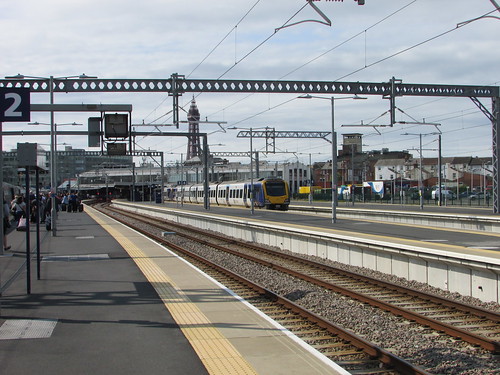
Blackpool North Station, with passengers streaming off recently-arrived Class 390 in platform 1 and a Class 331 in platform 4 (Blackpool by Electric Train)
I made my way out of the station and found the pedestrian underpass under High Street closed, leaving the rather narrow series of ramps to Talbot Road as the exit. Various temporary arrangements for road traffic had been made and it became clear that although the former Wilco building had been demolished, the planned new tram terminus I'd learnt about on my last visit in 2019 was nowhere near complete and the new hotel to be operated by Holiday Inn had only reached the stage of some structural steelwork erected. The double track tram line from the promenade reached an inset scissors crossover in course of installation.
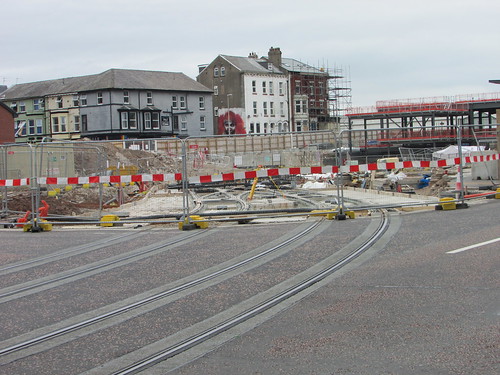
Scissors Crossover being installed at Blackpool North Tram Station building site (Blackpool by Electric Train)
I walked down Talbot Road towards the Promenade past plenty of holiday-makers enjoying the good weather. I noted that no overhead conductor had yet to be fitted on the 'new' tram lines and at Talbot Square, where the extension to the railway station makes a triangular connection with the existing route along the Promenade, there were more temporary road traffic arrangements. I'd found that the modern trams were running five an hour each way, so I managed to reach the North Pier tram stop just before a tram to Fleetwood arrived. I always enjoy the tram ride to Fleetwood, past Blackpool's well-known hotels.

Imperial Hotel, Blackpool (Blackpool by Electric Train)
After passing through through Cleveleys the tram route turns away from the coast and enters Fleetwood threading through Lord Street, the main shopping street looking a little shabby after difficult economic times, finally terminating at Fleetwood Ferry adjacent to the small public Euston Park, in front of the imposing North Euston Hotel and in sight of the estuary of the River Wyre.
I walked across to the entrance to Fleetwood Ferry and realised that the small ferry at the slipway was loaded with passengers. I checked the chalkboard displayed and found the ferry was just about to leave, although I was puzzled to read 'Last ferry 1.45 pm' which seemed rather early. A sign indicated I should pay the fare on the ferry so I hurried down the slope to the ferry, joining a man who'd just emerged from the ferry building who I realised was the Ferry Captain. At the gangway, I paid the two pound fee to the other member of the two-man crew, the gangway was raised agains the side of the ferry and within seconds we started our 5-minute crossing of the mouth of the river, about a quarter of a mile. I'd not been on this fairly modern ferry before, broad-beamed with bench seats on all four sides (apart from where the gangway was fitted on the port side). The 'bridge' was a small podium on the port side in the passenger saloon provided with a raised, windowed lookout all-round. Access to the bridge was via a short, vertical ladder. The benches accommodated about thirty passengers, leaving space in the middle for pushchairs and bicycles. It was all rather homely.
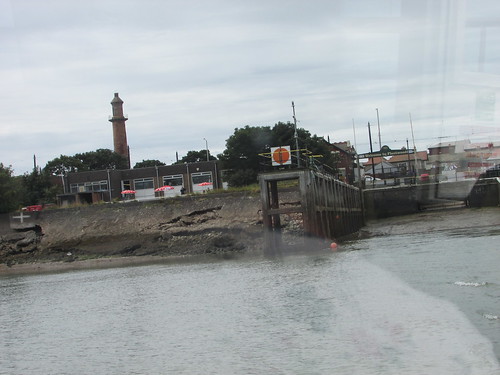
View of Fleetwood from the Knott End Ferry with the Upper Lighthouse or Pharos in the background (Blackpool by Electric Train)
Using the optical zoom on my camera, I managed a reasonable shot of the two nuclear power stations at Heysham, about 9 miles away in a direct line (but much further by rail or road), reminding me of my last visit to Heysham in 2019 described in the post Morecambe by Rail
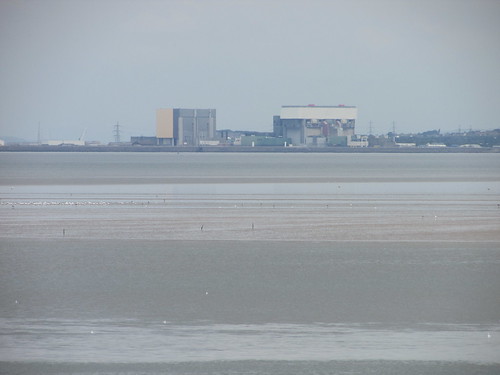
View of the two nuclear power stations at Heysham from the Knott End Ferry (Blackpool by Electric Train)
The ferry pulled alongside the concrete slipway at Knott End and the passengers disembarked. As passengers boarded for the return journey, I was able to take a picture of the ferry, named 'Wyre Rose'.
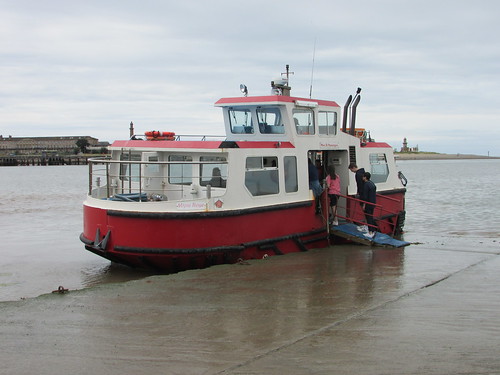
The Knott End Ferry 'Wyre Rose' loading passengers at the Knott End Slipway (Blackpool by Electric Train)
Before walking up the inclined slipway, I took a picture to try to capture the elegant proportions of Decimus Burton's Queen's Terrace in Fleetwood.
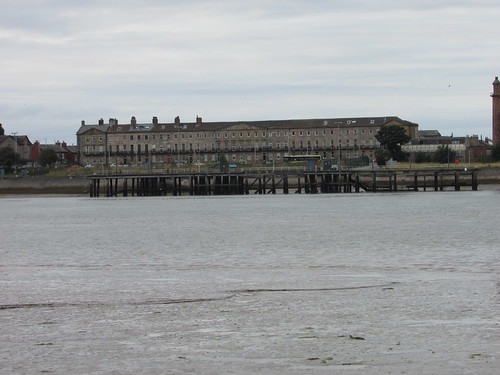
Queen's Terrace, Fleetwood, viewed from Knott End Slipway. The Terrace was designed by Decimus Burton and completed in 1844 (Blackpool by Electric Train)
The lower part of the slipway was wet and covered with fresh sandy mud and seaweed, making me realise why the last ferry was at 1.45 - the tide was still going out and this seemed to be confirmed by the length of exposed slipway before reaching land.

Landward view from Knott End Slipway: (L) modern apartments (R) Knott End Cafe and H. M. Coastguard (Blackpool by Electric Train)
Wishing to return on the ferry before it stopped, I cut short my visit to Knott End. I decided I might not have sufficient time for something to eat at the Knott End Cafe so, instead, I sat in the sun taking in the view of the River Wyre and Fleetwood as the ferry crossed to Fleetwood, took on a fresh complement of passengers and came back to Knott End. As I started to make my way back down the slipway, I was joined by quite a few other passengers. As the ferry came alongside, I was surprised to see a generous discharge of water from a hose controlled by the crewman which I concluded was to remove the worst of the sandy mud and seaweed from the slipway at the landing place. The crewman held out a plastic bucket for the two pound fare whilst the captain offered each passenger a squirt of hand sanitiser. We were soon under way on our short crossing.

The Knott End Ferry 'Wyre Rose' returning to Fleetwood showing the offset 'bridge' and passenger saloon (Blackpool by Electric Train)
Back at Fleetwood, I decided a light meal was indicated. A short walk took me to the Cafe Royal on Bold Street, which proved a wise choice. Suitably refreshed, I made my way south along Upper Lune Street, past the walled premises of Fleetwood Bowling Club which was established in 1880 and has two crown bowling greens set in a private location, stopping to record the distinctive Upper Lighthouse. Wikipedia has a short article here.
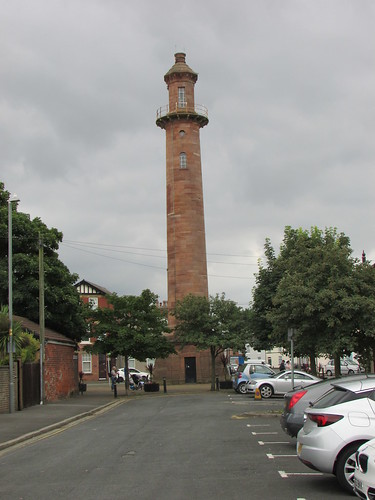
The Upper Lighthouse or 'Pharos' at Fleetwood (Blackpool by Electric Train)
I then walked along Queen's Terrace to Fleetwood Museum, housed in the Grade II listed former Customs House, where I spent a very enjoyable hour or so studying the excellent, varied displays about Fleetwood and its history and chatting to the knowledgeable staff. The museum website here gives more information about this splendid museum.
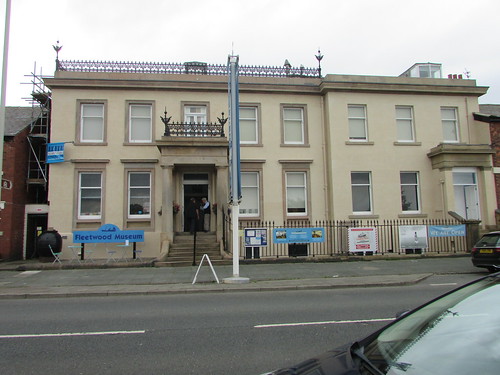
Former Custom House at Fleetwood, built 1838, is now Fleetwood Museum (Blackpool by Electric Train)
Although I was quite near the well-known Fleetwood Market, I decided against a visit on this trip and I was not tempted to make the longer walk to the 'shopping village' which used to be called Freeport Fleetwood but is now 'Affinity Lancashire', one of 45 outlets owned by Global Mutual. My post here describes a visit to the 'shopping village' in 2016. Instead, I walked back to the Fleetwood Ferry (where 'Wyre Rose' was moored up until the following day) and spent a while on the sandy beach next to the odd-looking River Wyre Launching Facility which is part of Fleetwood Nautical Campus, presumably used for safety training.

River Wyre Launching Facility viewed from the shore (Blackpool by Electric Train)
It was very peaceful as I watched an unidentified Stena Line Ro-Ro ferry slowly making its way towards Heysham but, noting the time, I made my way back to the tram stop I'd arrived at and boarded the waiting tram for the journey back to Blackpool.

View from Fleetwood beach, with remains of the Wyre Light on the right and Stena Line Ro-Ro ferry in the distance making for Heysham (Blackpool by Electric Train)
As we neared Blackpool, the famous Blackpool Illuminations were nearing readiness. In 2021, following the disruption caused by the Covid-19 Pandemic, 'The Lights' are to have an extended season extending from 3rd September 2021 to 3rd January 2022.
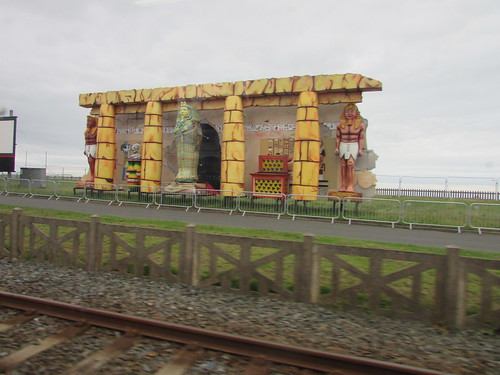
View from my tram of just one of the illuminated displays, this with a Egyptian theme (Blackpool by Electric Train)
I left the tram at North Pier and walked towards the Tower for the obligatory photograph, managing to include one of the preserved trams carrying out a 'Heritage Tour'. Whereas the modern trams are serviced at a new depot at Starr Gate, the Heritage Trams remain at the original tram depot at Rigby Road. My post in 2019 here mentions the Rigby Road Depot.

Blackpool Tower with one of the preserved trams on a 'Heritage Tour' departing from the dedicated 'Heritage Tram Stop' marked by the green sign attached to the lamp post (Blackpool by Electric Train)
I took a picture of the North Pier with the tide out, chatted to an inquisitive seagull who flew off once he realised I'd nothing edible and made the customary brief pilgrimage to North Pier before deciding it was time to walk back up Talbot Road to Blackpool North Station for the 17:47 Avanti service back to Wolverhampton.

Blackpool North Pier with the tide out (Blackpool by Electric Train)
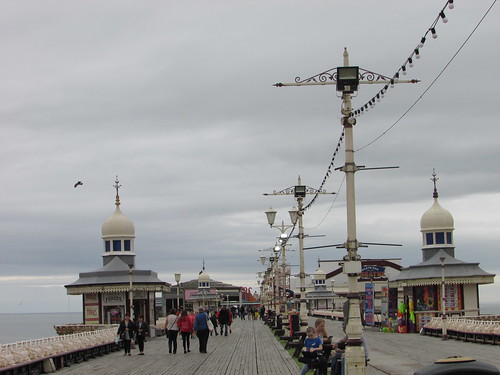
Blackpool North Pier (Blackpool by Electric Train)
Before descending the steps and ramp leading down from Talbot Road to the station forecourt, I paused to take in the scene. The train I was to catch had not yet arrived from the south. The warehouse-like main station building is without architectural pretension but does provide an unemcumbered concourse area with good natural light, set at right angles to the terminal platforms outside accessed through a series of doors.
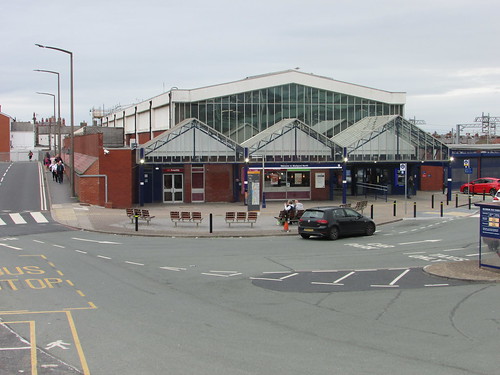
The main building at Blackpool North Station covers the concourse area and is set at right angles to the terminal platforms seen on the right (Blackpool by Electric Train)
By the time I'd made my way to the station and passed through the ticket gateline onto the concourse, my train had arrived and passengers, most with wheeled suitcases, were streaming out. Almost immediately, staff allowed the waiting queue onto the platform to board the train.

Passengers leaving the recently-arrived Class 390 as departing passengers board (Blackpool by Electric Train)
I settled byself in the reserved seat and after a few minutes, we set off, making good time to Preston where we were stopped for a few minutes at signal PN126 - the last signal before entering the platforms. We made our booked stops at Wigan and Warrington then at Hartford Junction we passed a stationary train on the Up Slow of West Coast Railways stock hauled, I think, by a Class 57 on some sort of special, apparently waiting for us to precede it on the double track section. I had time to use the live display provided by Railcan UK to identify the special as 1Z57 then, approaching Crewe, we were stopped for a few minutes at signal CE144 - the last signal before entering the platforms. After a short wait, we were allowed into platform 5. Just before we left platform 5, I captured the Railcan UK screen on my mobile, showing my train (9M59) on the right and the special (1Z57) held, as we had been, at signal CE144.

Railcam UK shows the situation at Crewe station as my train (9M59) is about to leave platform 5 (Blackpool by Electric Train)
Click for larger view
As we spooled off the miles to our Stafford stop, Railcam UK showed me that 1Z57 had crossed to platform 11 at Crewe - the platform usually used by 'specials'.
Approaching Stafford, my train was given precedence over a Cross Country 'Voyager' from Manchester on the Up Slow which followed my train to Wolverhampton.
Just north of Wolverhampton, we were once again brought to a brief stand before being brought into platform 4. I left the train after a splendid day out and caught a taxi home.

Wolverhampton, showing 9M59 from Blackpool in platform 4, ready to go forward to London Euston (Blackpool by Electric Train)
Related posts on this website
Blackpool by Train (Visit in 2019).
Return to Blackpool and Fleetwood (Visit in 2016)
A Trip to the Seaside (Visit in 2014)
My pictures
This trip:-
Blackpool by Electric Train
Depending on the display device, the right hand edge of pictures may not display. To see an uncropped image, click on the picture. Alternately, you can find the image by following the 'My pictures' link and display or download the image in various resolutions.
My last visit to Liverpool area had been on 14th March 2020, just before the UK government introduced a comprehensive Lockdown in response to the Coronavirus Pandemic. That trip is described here. Sixteen months of varying restrictions on life and travel followed. Not being very superstitious, I chose Friday 13th August 2021 to return by train for a day trip.
The day before my trip, I'd managed to book train tickets, after some difficulty with the online 'app'. The government advice was strongly recommending social distancing (and mask-wearing in crowded locations) so I decided to travel First Class.
Our local buses were operating a reduced service and I decided I'd better take the 07:30 service from Brewood, not being quite sure whether the next bus (the 08:35) was actually running. I was the only passenger on the 07:30 bus, although two other passengers had joined before we reached Wolverhampton. The usual walk to the railway station followed, through the seemingly perpetual obstacle course of roadworks affecting the station approach road from the town. Technically, Wolverhampton is now a city but it has never managed to generate the sense of excitement that a decent city evokes. The road approach to the station is now via a very indirect and congested route (for which my company's former premises in Corn Hill were sacrificed). The original approach has been converted to carry a double-track extension to the station for the West Midlands Metro which the operators claim will open later in 2021.
The new station buildings at Wolverhampton Station are now in use but manage to appear, to me, even uglier than the British Rail brutalist structure they replace. Pedestrian access at present is a convoluted passage through ongoing building works. Refreshment facilities are currently limited to what appears to be a 4-wheel converted horsebox parked outside the new building. Brave new world!
The 08:21 to Liverpool arrived on time - two 4-car Class 350 'Desiro' Electric Multiple Units. I found a seat in the First Class section of the leading 4-car set. There was one other passenger already there and two more passengers joined at later stops but with good soundproofing I found it quite pleasant, although the 'swishing' of the air conditioning (possibly turned well-up as a Coronavirus infection mitigation measure) was noticeable. With 'air bag' suspension the Class 350 ride well and the route has Continuous Welded Rail virtually throughout. We had an uneventful run through the familar territory and rolled into Liverpool Lime Street on time at 09:40.
I walked to the main booking office to purchase a 1-day All Areas 'Saveaway' ticket which would cover whatever travels I decided to take. I knew I would start with a descent to the underground Merseyrail station at Lime Street, taking a train on the single-line 'Liverpool Loop' two stops to James Street. The 'Liverpool Loop' was an ingenious solution by British Rail to the problem of improving access to the underground system which originally only went to Central Station, not serving Lime Street at all. Traversing the deep level 'Loop' meant that incoming trains were 'reversed' to become outgoing trains.

Liverpool Loop 1977 (Wikipedia)
Click for larger image
In common with all transport enterprises, Merseyrail was operating a 'Coronavirus' schedule which, on the Wirral Line, meant three trains an hour from Liverpool to Chester, West Kirby and New Brighton and two trains an hour to Ellesmere Port, so having descended to platform level by escalators I didn't have long to wait as all trains from Lime Street go to James Street. The fleet is still 3-car EMU Class 507 and Class 508/1 built between 1978 and 1980 but new Statler-built 4-car Class 777 are starting to arrive for pre-service testing. Merseyrail have announced that Class 777 'ghost trains' have been added into the service pattern, stopping at all stations but not boarding passengers. At James Street, a short flight of steps led from the platform to the 'mezzanine' level immediately above the tunnels and then a series of large electric lifts returned me to ground level.
Outside, there was bright sunshine and it was a pleasant walk of half-a-mile to the Museum of Liverpool near Pier Head. Strand Street appeared to be undergoing major alterations so it took a moment to determine the best way to cross into Mann Island but I still reached the Museum at ten o'clock, as the doors were opened. My visit, as usual, was to check on one of their major exhibits, the locomotive 'Lion', dating from 1838. I'm still Secretary of the 'Lion' supporters group The Old Locomotive Committee but the Covid Pandemic has cancelled the group's face-to-face activities for two years. The locomotive was secure (if a little dusty) and the video interpretations on-demand appeared to be in order. A note adjacent to the selection pushbuttons claimed that a special coating had been applied to reduce the chance of contact infection.

Liverpool (again): Locomotive 'Lion' in the Museum of Liverpool (yes, that's me pontificating on the left hand small screen).
Should you wish to find out more about 'Lion', both prototype and models, or the Old Locomotive Committee, all my posts on this topic are here.
Having completed my 'inspection' I was soon back outside. It was sunny with a bracing wind coming off the river and I had an enjoyable walk along the quay and around the elegant Old Pilotage Building as I watched Mersey Ferry 'Snowdrop' (still in her 'Razzle-Dazzle' livery) make her way to Birkenhead Woodside on the opposite bank of the Mersey.

Liverpool (again): View looking south along King's Parade showing the rear of Albert Dock Warehouses.

Liverpool (again): Mersey Ferry 'Snowdrop' dwarfed by the Stena Line Ro-Ro ferry preparing to depart.
I watched as the Stena Line ferry eased away from the Twelve Quays berth and turned through 180 degrees so as to point seawards. I assumed she would stay more-or-less mid-channel en route for Belfast but a little later I could she that she'd manoeuvred towards the Liverpool shore. I didn't solve the puzzle as I could also see 'Snowdrop' making her way back to Pier Head and I wanted to catch her 11:00 departure. By the time I'd walked to the Mersey Ferry booking office, secured my ticket and queued for boarding (the sailing seemed very busy), the Stena ferry was out of sight, my view blocked by the alien-looking bulk of the 96-metre long HSC 'Manannan', the High Speed, wave-piercing passenger/Ro-Ro Catamaran at the berth just north of Pier Head used by the Isle of Man Steam Packet Company.

Liverpool (again): View from Mersey Ferry 'Snowdrop' of the bow of the 96-metre long HSC 'Manannan', the High Speed, wave-piercing passenger/Ro-Ro Catamaran
Normally, the Ferry sails from Pier Head to Seacombe in a generous loop downstream, then proceeds upstream to Birkenhead Woodside and finally returns to Pier Head in a generous loop upstream. However, I'd learnt that Seacombe ferry terminal was closed for major maintenance and redevelopment. The Mersey Ferries site reports:-
The works will see the linkspan bridges, which are over 130 years old and coming to the end of their operational life, replaced and the landing stage undergo a major refurbishment, including upgrading the mooring bollards and installing new powered gangways. The pontoon will be removed from the water to carry out these works.
'Snowdrop' slipped away from Pier Head a few minutes late, having waited for passengers, and we headed downstream passing the familiar features on the Liverpool side whilst the pre-recorded commentary explained some of the history of the city and its landmarks. Level with Wallesey Town Hall, we turned across channel and I could see the Stena ferry making its way downstream near the deepwater port Liverpool2, equipped with eight massive container cranes but untroubled by a container ship that day. Modern large container ships are rarely alongside at a port for more than a day, whilst multiple container cranes unload and load shipping containers, then the next voyage commences, making best utilisation of the expensive asset.

Liverpool (again): Outbound Stena Line Ro-Ro ferry passing the deepwater port Liverpool2, with its 8 Chinese-built container crames.
The ferry turned upstream and sailed imperiously past Seacombe ferry terminal, looking very odd with both linkspan bridges removed, isolating the pontoon.

Liverpool (again): Seacombe ferry terminal looking very odd with both linkspan bridges to the pontoon removed
We continued past the Ro-Ro ferry berth at Twelve Quays, empty following the earlier departure of the Stena Line ferry.

Liverpool (again): The empty Ro-Ro ferry berth at Twelve Quays, with the buildings of Birkenhead Docks behind
'Snowdrop' passed Birkenhead Woodside ferry terminal, then made a 180 degree turn to starboard so as to come alongside the pontoon against the incoming tide, moored, and the manually-operated gangway was aligned and lowered into place. I disembarked and walked through the linkspan bridge. This was fairly inclined because the tide was still coming in and the Mersey has a tidal range of 4 metres (neap tides) to 13 metres (spring tides). I afterwards looked up the Gladstone Dock predictions for that day which gave low tide a little before 10:00 with the level rising by 7.5 metres by high tide just after 15:00. At each ferry terminal, the floating pontoons and the hinging linkspans allow ferries to operate at all states of tide.
Having passed through the terminal building, I then had a walk of a few hundred yards to the Merseyrail station at Hamilton Square, where my 'Saveaway' ticket allowed me to take one of the large, electric lifts to the mezzanine area then I took the steps to the platform for trains to West Kirby and New Brighton. I boarded the first train which was bound for West Kirby but then decided to change at Birkenhead North (before the two routes diverge) and wait for the following New Brighton train. I thought that I might catch a glimpse of one of the new Class 777 trains as we passed the depot just past Birkenhead North station but all I could see was a row of 'old' trains. We made brief stops at Wallasey Village and Wallasey Grove Road stations and, looking north, the sea came into view. My enjoyment of this sight was somewhat reduced by the sight of the Burbo Bank and Burbo Bank Extension offshore wind farms.
The Burbo Bank wind farm, owned by Ørsted, came into use in 2007 and can produce up to 90 MW of power from 25 wind turbines. Power comes ashore via an undersea cable to a substation in Wallasey.
The Burbo Bank Extension wind farm, to the west of the original installation is 50% owned by Ørsted together with PSA and 'Lego' owners Kirkbi and was commissioned in 2017. It can produce up to 258 MW of power from 32 wind turbines. Power comes ashore near Rhyl via an undersea cable which then connects to a substation at Bodelwyddan.
New Brighton station is a neat, 2-platform affair. The original staion building in red brick built by the Wirral Railway survives and extensive external scaffolding pointed to repairs being carried out. The platform has a reinforced concrete umbrella roof, which I assume is an L.M.S. legacy. With staffed booking office, toilets and a small cafe it's a reminder of what railway stations should be like.

Liverpool (again): New Brighton station, view looking towards Birkenhead North
The shortest walk to the sea is to the north-facing promenade but I always prefer the longer walk along Victoria Road to the east-facing promenade looking across the Mersey to Seaforth and its docks. I stopped to record the post box outside Wallasey Post Office which has acquired an eleborate, knitted hat featuring 'Olly Octopus'.

Liverpool (again): The post box outside Wallasey Post Office has an eleborate, knitted hat featuring 'Olly Octopus'
The fish and chip shop which I've used before was firmly closed but Victoria Road offers a number of alternatives for food and drink so instead I stopped for a light meal at the Smuggler's Cave cafe, which was enjoyable and excellent value. Somewhat restored, I completed my walk to the familar seafront, emerging near what was, when I was young, the entrance to the pier. The beach looked inviting so I made my way down the ramp onto the sandy shore I'd first visited over 70 years previously. Looking to the north, Fort Perch Rock (the fort built in the 1820s to protect Liverpool) and the now-decommissioned New Brighton lighthouse were visible.

Liverpool (again): New Brighton beach with Fort Perch Rock and New Brighton lighthouse in the background.
Wikipedia has an article on Fort Perch Rock here.

Liverpool (again): The older Liverpool Docks viewed from the beach at New Brighton
The view across the River Mersey from New Brighton has changed considerably since my first visit. Seaforth Dock was opened in 1971 and, more recently, Liverpool2 has added deepwater berths and the eight massive, red container cranes which dominate the view.

Liverpool (again): View from New Brighton Promenade showing Liverpool2 with Seaforth Dock behind as a dredger heads upstream
I left the seafront and headed back up Victoria Road towards the railway station. Rockpoint Leisure have been involved in a regeneration project seeking to create a new cultural heart for New Brighton and the 'Victoria Quarter', as they term it, is certainly home to an eclectic mix of premises. I was intrigued by a display of historical photographs from a previous art exhibition by Devil's Nest showing New Brighton Pier, finally lost in 1972.

Liverpool (again): Historic aerial view of New Brighton with Fort Perch Rock near top, New Brighton Tower building intact but tower demolished. Victoria Road runs left to right, terminating near the entrance to the Pier with its ferry landing stage (from a picture displayed by Devil's Nest)
There's some information about the pier on the National Piers Society site here.
When I arrived at the railway station, a train was already waiting, with a number of passengers already aboard and still a few minutes before departure, so I settled myself for the journey back to Birkenhead Hamilton Square.

Liverpool (again): The landward view leaving Wallasey Village station
I'd not yet seen one of the new Class 777 trains, so I kept a good lookout as we approached the depot at Birkenhead North, in the hope of parhaps catching a glimpse. There was one odd trainset, part hidden hehind a row of the usual EMU but it was a Vivarail Class 230, now used on the Transport for Wales Bidston - Wrexham services.

Liverpool (again): Transport for Wales Class 230 at Birkenhead North Depot. Various versions have been created by Vivarail, completely remodelling redundant London Underground 'D' stock
The train would have taken me directly to Lime Street Station, passing under the Mersey in the tunnel opened in 1886 (described in a post here) but the lure of the Mersey Ferry was too great so I left the train at Birkenhead Hamilton Square and re-traced my footsteps back to Woodside Ferry Terminal.

Liverpool (again): Birkenhead Woodside Ferry Terminal Building
Once again, I was lucky with my timing as the ferry was due in just under 10 minutes. I watched a red-painted 'UNIBALTIC' petrol/chemical tanker, riding very low in the water, head downstream and then 'Snowdrop' appeared and passed the landing stage heading upstream before turning 180 degrees so as to make a final approach to the pontoon.

Liverpool (again): 'Snowdrop' approaching the Landing Stage at Birkenhead Woodside
Unusually, 'Snowdrop' came against the landing stage with an audible 'clang' and, as the gangway was lowered, there was noticeable movement between the ship and the pontoon but passengers disembarked and boarded without too much difficulty. We were quickly underway again, pulling away from the pontoon heading downstream then turning upstream to give views of the Cammell Laird Shipyard on the Birkenhead river bank. I managed to identify Royal Fleet Auxiliary A139 'Tideforce' in the Wet Basin. Launched in 2017, 'Tideforce' is the last of four Tide-class replenishment tankers built for the British Royal Fleet Auxiliary by Daewoo in South Korea. On my previous trip to Liverpool in 2020 here, I'd seen A137 'Tiderace' and A138 'Tidesurge' in the same Wet Basin.

Liverpool (again): Royal Fleet Auxiliary A139 'Tideforce' in the Wet Basin at Cammell Laird Shipyard, Birkenhead>
We continued upstream as far as Tranmere Oil Terminal which receives all the crude oil processed by the Essar Oil Refinery further upstream at Stanlow. There's more information on the Essar Oil site here. An unidentified tanker was moored. Crude oil arriving at Tranmere reaches the Essar Oil refinery at Stanlow via a 15 mile pipeline.

Liverpool (again): Unidentified tanker moored at Tranmere Oil Terminal. Note tug near port bow.

Liverpool (again): View looking upstream from 'Snowdrop' as she heads across the river to the Liverpool side, with Stanlow refinery in the distance.
We made the customary smooth approach to the pontoon at Pier Head and, as I disembarked, I could see that there was a good crowd waiting to board. I spent a little while wandering around the Waterfront area, enjoying the good weather. I was amused by a Rolls Royce car which arrived, decorated in rather 'fairground' style, delivering its passengers to Pier Head.

Liverpool (again): A Rolls Royce, in flamboyant livery, delivering its passengers to Pier Head.
Once again, I was impressed with the appearance of the Grade II* Port of Liverpool Building, now in private ownership. There's a Wikipedia article here. The elaborate cast iron gates face the Waterfront and shields incorporate the initials 'MDHB' in script characters for the Mersey Docks and Harbour Board who erected the building, which was finished in 1907. The larger, stone gate piers are topped with large balls, decorated with outlines of the continents, forming a globe of the earth.

Liverpool (again): Port of Liverpool Building
I then walked back to James Street Merseyrail station, descended to platform level and caught the arrival next from Birkenhead. I still had well over an hour before the train I had booked back to Wolverhampton. I toyed with the idea of taking a ride on the Northern Line (one way or another) but was reluctant to risk running out of time so I travelled to Lime Street station, where I found an imminent departure to Crewe via Manchester Airport whose first stop was just five minutes out of Lime Street at Edge Hill station. Unable to resist this temptation, I made my way to platform 2 where I found a Northern refurbished EMU already 'full to the gills' with a stream of passengers still trying to join the train. I managed to squeeze onto the first coach but a few people decided against using the cramped train. A few minutes later, I got off at Edge Hill. It was my first ride on one of Northern's second-hand EMU.

Liverpool (again): Edge Hill station. The freight train standing in Tuebrook Sidings on the left is imported biomass via Liverpool Docks for Drax Power Station
I discovered there was a train to take me back to Lime Street in just a few minutes so, rather than risk getting stranded waiting for a later service, I decided to take it. This train comprised two 4-car sets of Class 331 EMU built by CAF in Spain and brought into service in 2019. Although I'd seen the Class 331 in various locations this was my first ride on this class. Fairly comfortable (and not crowded as my outbound journey).
Safely back at Lime Street, there was still some time before catching the 16:47 Avanti service to London so I had a walk around the St. Johns shopping district before puchasing a drink and a snack at Marks and Spencers inside Lime Street Station before finally boarding the Class 390 'Pendolino', reporting number 1A57, at platform 9. This service stops at Liverpool Parkway, Runcorn and then Stafford arriving 17:40, so I had the experience of speeding through Crewe on the Up Through. After Stafford, this train then takes the Trent Valley line to Rugby. At Stafford I changed to the West Midland Trains service which was following from Crewe to complete my journey back to Wolverhampton.
Whilst waiting on Stafford platform 4, a down Freightliner train going well hurried through platform 5, hauled by a pair of Class 90 electric locomotives. Impressed by the sight, I afterwards used Railcam UK to identify the train as 4M88, a regular service from Felixstowe (departing 09:32) via Ipswich, Stratford, Willesden, Northampton, Nuneaton and Crewe terminating at the O'connor Freightliner terminal at Ditton. I hadn't realised that Freightliner were 95% owned by an American company, Genesee & Wyoming. Wikipedia has a useful article here.
West Midland Trains quickly returned me to Wolverhampton and finally a taxi took me home, where I arrived very tired but very pleased with the day.
My pictures
Liverpool (again)
Depending on the display device, the right hand edge of pictures may not display. To see an uncropped image, click on the picture. Alternately, you can find the image by following the 'My pictures' links and display or download the image in various resolutions.
[Minor edits 24 Aug 2021, 26-Aug-2021]
My first visit to Myanmar was in 2008 and I became fascinated by this British-built but so different railway system which had struggled for survival during long years of the country's isolation under army control. In my post Passenger Rolling Stock in Burma, written back in 2013, I outlined the variety of liveries I'd seen on passenger coaches. On each of my subsequent visits, I've tried to learn a little more about Myanma Railways.
During the second of two trips I made to Myanmar in 2017 (you can find all the posts on that trip here), my friend arranged a visit to the Carriage and Wagon Workshops in Myitnge, near Mandalay. My pictures taken during the visit are here.
The British-designed Carriage and Wagon Workshops at Myitnge opened in 1905. New passenger carriage building started in 1947 and, when I visited in 2017, new carriages of well-established design were still under construction although the main activity of this area, now designated Shop No. 2, was heavy repairs.
In the past, travellers on Myanma Railways could experience some fairly uncomfortable riding at times, due to a combination of poor track maintenance and vehicle suspension and draftgear. Major works on permanent way improvement (including the introduction of Continuous Welded Rails) and the introduction of Chinese-built coaches with air bag suspension were put in hand.

Myitnge Carriage & Wagon Workshops with Shop No. 2 near the centre and Shop No. 3 (with blue roof) under construction just visible at the top (Image: Google Maps)
Click for larger image
Shop No. 2
The shop comprises a number of parallel bays, aligned more-or-less north-south, each provided with an overhead travelling crane and a number of inset sidings allowing complete coaches to be worked on.
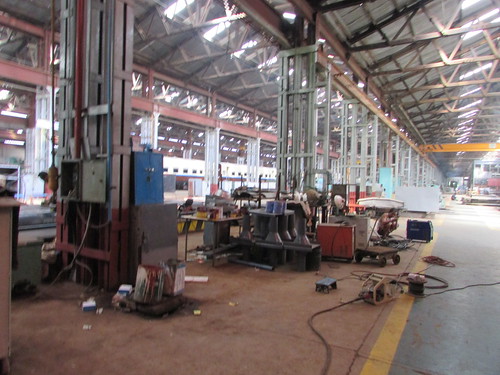
Myitnge Carriage and Wagon Workshop: General view of Shop No. 2

Myitnge Carriage and Wagon Workshop: Shop No. 2 showing completed carriages (l), carriage sub-assembly jigs with welding in progress (r)

Myitnge Carriage and Wagon Workshop: Assembling new carriage side panel in Shop No. 2

Myitnge Carriage and Wagon Workshop: 'Mini-Ostrich' gas profile cutting machine in No. 2 Shop

Kanto Yuatsu Power Press in No. 2 Shop
![]()
Myitnge Carriage and Wagon Workshop: Production plan for two types of new-build existing-design coach - 30 off BDTEZ and 10 off BDUEZ in 2017-2018
Outside the north end of Shop No. 2, an impressive electric traverser carried on six parallel rails is provided to transfer complete coaches between the various sidings.

Myitnge Carriage and Wagon Workshop: Coach Traverser with Bogie Shop in background
To the north of the traverser the separate, more recently built, Bogie Shop produces various types of bogies used on Myanma Railways.

Myitnge Carriage and Wagon Workshop: Assembly jig used during Bogie Frame construction in Bogie Shop
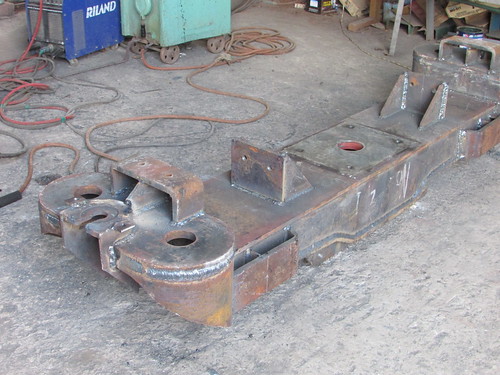
Myitnge Carriage and Wagon Workshop: Bogie sub-assembly fabrication

Myitnge Carriage and Wagon Workshop: TKZ8 Bogie Frame assembly Plano Miller in Bogie Shop
I was impressed by the quality of workmanship and the results achieved by these generally rather elderly workshops. But an ambitious project to build a new facility for the production of the Chinese coach design in Myanmar was well underway and, during my 2017 visit, I was able to tour the construction site which lies to the north of the traverser mentioned above.
Shop No. 3 under construction
The impressive high-bay building was largely complete and fitting-out was in progress. It comprises multiple bays, aligned north-south, each provided with a number of Hena Sinoko Chinese-built overhead travelling cranes. In the unfinished storage area outside the building there was also a large Chinese portal crane.

 Myitnge Carriage and Wagon Workshop: Shop No. 3 for producing coaches with air-suspension.
Myitnge Carriage and Wagon Workshop: Shop No. 3 for producing coaches with air-suspension.
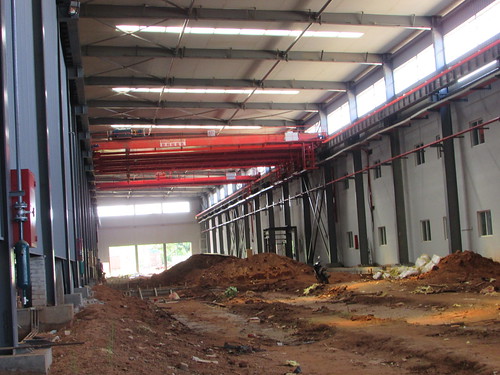
Myitnge Carriage and Wagon Workshop: Shop No. 3 under construction
Work was in progress to complete the massive concrete foundations for heavy machinery and lay the various sidings. The rest of the floor area was being prepared for the final finish of concrete. At least one excavator and a couple of roller/compactors were inside the building. A conventional diesel roller type 3Y12/15A (made by the China state-owned company XCMG) was parked but the LuiGong 'sheepsfoot' diesel compactor rumbled up and down throughout my visit, imprinting the soil with its characteristic pattern. A layer of crushed stone was being laid on top of the soil before being rolled ready to receive concrete. As is usual in Myanmar, most of the work carrying and laying stone was being carried out by women, using woven baskets to carry stone upon their head.


Myitnge Carriage and Wagon Workshop: Gang laying stone foundation in Shop No. 3
The Chinese coaches
I saw one of the imported Chinese carriages, lifted off its bogies, during my visit to the works in 2017.

Myitnge Carriage and Wagon Workshop: Modern Chinese coach bogie with air bag suspension units
Later in that trip, I saw a couple of trains that use these coaches on the Yangon - Mandalay services.

The afternoon express from Mandalay to Yangon formed from modern, Chinese-built 'air-bag suspension' coaches passes Myo Haung Signal Cabin

Mahlwagon Main Line seen from the north end of the Up Yard showing Train Number 5 Up (the 15:00 hours Yangon-Mandalay, due to arrive 05:00 the following day) with a Chinese-built Bo-Bo-Bo on a rake of Chinese-built 'air-bag suspension' coaches.
Factory opening
I understand that Shop No. 3 started manufacture in 2018 with an initial build of 15 coaches of Chinese design in Shop No. 3. More recently, Shop No. 2 has been involved in the construction of a batch of 80 coaches of Korean design. However, the Covid-19 Pandemic has prevented visits in 2020 and 2021. Following elections at the end of 2020, on February 1st 2021 the election result was repudiated by the Myanmar army who seized power alleging voter corruption so the current situation is unclear.
Revised version
It's a large works and I had initially misunderstood the numbering of the three shops but, guided by my friend who organised the tour in 2017, I've tried to correct this.

Myitnge Carriage and Wagon Works showing older Shop 1 (lower view), Shop 2 and modern Shop 3 (upper view)
My pictures
MR: Myitnge Carriage and Wagon Workshop
Passenger Rolling Stock in Myanmar
[Shop numbering corrected: 11/05/2022]




































































